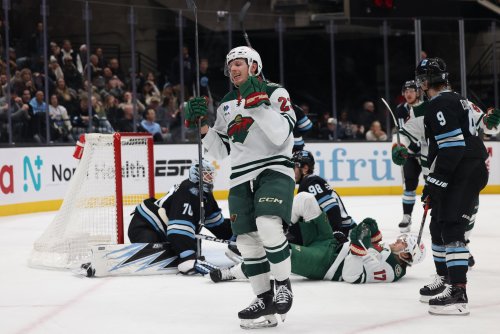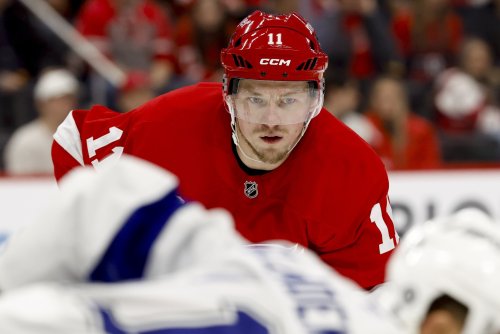
DES MOINES, Iowa - It may have been awhile, but I want you to think about math for a second, no matter how painful that might be. In the world of quantum mechanics, the quantum deals with particles that are not perceived by the senses, specifically the spin of electrons. This is unimportant, but it was the first experiment that I was introduced to. The idea of Erwin Schrödinger’s black box in which, given it’s measured along a the same axis, something either “is” or “isn’t”.
Think of the season as a singular axis comprised of nights where a player is either performing or they’re not. Now, quantum theory is much more complex than this simple experiment as is hockey, but if you want to apply a player’s point production with a given set of variables, it can make some sense: either your favorite player is scoring a point, or they’re not. There is no in-between. Which is why when you measure qubits, your results with the black box are +1 or -1, never 0.
With that in mind, and thinking that plateaued point charts still emphasize the upward trend of compiling points over a season which can be deceiving, I decided to give players negative values for nights that they hadn’t recorded a point. Negative values, at least in my opinion, are a better visual representation of how a player’s performance ebbs and flows in a season. For example, Sam Anas’ team leading 31 points in 33 games (14 goals, 17 assists) becomes +19 in value - still the highest on the team, and he has a lot more games where he has scored a point than ones where he hasn’t.
The downside to breaking down players like this, among other reasons, is that it is a single-minded approach, and defensemen get a bad rap because they’re not going to be contributing many multi-point evenings like Sam. The offensive-defensemen will get a better look, while the guys still working on their overall game will look worse than they actually are - Ryan Murphy and Zach Palmquist are the highest ranked defenseman at -1.
Using a roster breakdown model put out by Jeff Veillette at The Faceoff Circle, Iowa’s roster has been split into three separate categories, four charts for the sake of cleanliness, based upon player age: development (18-23), bubble (24-27) and veteran (28+). If you take a look at Jeff’s charts, Iowa is dead last in terms of veteran talent with three players, which isn’t a big deal considering the A is a development league. On the other side, Iowa is also dead last in terms of development age players, but there should also be no reason to ring the alarm, as a multitude of players are still in college or playing in major junior leagues. However, their “bubble” roster is the highest valued - no doubt just by numbers alone.
So what do we have here? When looking at the chart, there should be few surprises. Justin Kloos is currently just two points behind veteran Cal O’Reilly for second in points behind Sam Anas. The former Gopher hasn’t missed a single game this season, even when he got his cup-o-coffee, hence the continuous line. He hasn’t dipped into the negatives since Oct. 28th, pointing to his ability to be a consistent scorer in the line-up.
He’s played everywhere and in every situation. Early on, Iowa assistant coach David Cunniff had Kloos playing the point in a 4F1D approach to the power play, but he’s since moved to down to the wing in those situations. The Lakeville native also spent time on the wings a quarter of the way through the season, but head coach Derek Lalonde has struck a well of speed and skill placing Kloos at center between Anas and Gerald Mayhew to great success.
You may ask yourself, “what’s with the breaks?” A couple of reasons. Looking at Luke Kunin, for example, he received a call-up from the big club. In keeping with the +/- approach, it’d be unfair to give a minus to a player not on the ice. He has also missed the last few games due to injury via a blocked shot against the Manitoba Moose (Winnipeg Jets). Whereas Kloos has brought forth success in 39 games, Kunin is still fluttering on that “break-even” point, though he is currently trending in the right direction.
On the defensive side, Brennan Menell is supposed to be the guy when it comes to development of the offensive-defenseman. In Lethbridge, he was a shade better than a point-per-game (71 in 70 games played), and Iowa has been a bit of an adjustment. He’s been a healthy scratch a few times, and as you can see, it’s hard to get out of the negative when you hit a scoring slump. Fortunately, he’s been more or less consistent in the last few months. Twenty-three year old Carson Soucy was not brought in for the same offensive prowess, the owner of 15 points in his senior year with Minnesota-Duluth. Even his defensive game needs a little work at this point, but his downward trend is a product of having played in all but two of Iowa’s games this season.
There is little left to say about the production of Anas this season. After missing the first six games of 2017-18, he’s easily been the best player in Iowa - a franchise record in consecutive games with a point, tied for the franchise record for consecutive games with a goal scored and ten multi-point games. Unfortunately, Minnesota has one of the most anemic cap spaces in the NHL and can’t even afford his light $792,500 cap hit. An eye for the puck, hands like lightning, a scoring presence we have never seen in Iowa, and he still was passed up as an AHL All-Star (though he’d be the next best thing if Kunin decides to take a pass).
Zack Mitchell looks a lot better here than a lot of his counterparts, but one could argue that he’s saved by the fact that he spent 18 games of Iowa’s schedule, all of December, playing with Minnesota. He deserved the call-up, don’t discount that in the slightest, as he was clearly a head above everyone else when you look at where his progression takes a pause. A name that deserves some more attention would be that of Kyle Rau. Despite Iowa being rather up and down when it comes to wins and losses, Rau has provided a great skating element to the left side of Lalonde’s offense. He has also been open-minded in changing his game to where he’s a net-front guy, along with Mario Lucia, when Iowa’s power play is in session; fifth best in the AHL at 20.6 percent.
As with Soucy, Nick Seeler is a victim of being a “defense first” player that has dressed in every game for Iowa this season. He’s the only defenseman that hasn’t been scratched, and that’s saying something that won’t show up in this chart or any one that is predicated upon points. That little bump leading up to today is his first goal of his professional career, and a pretty impressive one at that.
There are some that have clamored for Ryan Murphy, and as a former first-rounder with the added quality of a great shot from the point, there’s going to be room for praise. He did well in Minnesota in his limited time, and as the previously written article suggested, like with Anas, he’s “a victim of circumstance.” South St. Paul native, Zach Palmquist, has also been out of Iowa’s line-up, but not because of a call-up. There were deficiencies in his defensive game to start the season, and he’s never been known to be an elite scorer by any means, but he’s on pace for a career high in points, is tied for points with Murphy, and both have the same amount of multi-point performances from the blueline this season - three.
Some food for thought.
At last, we come to the veteran presence on the Iowa Wild. For practical purposes, these are some names you might not otherwise hear up in St. Paul, but they play a very important role in player development. They right the ship, chipping in offense in order to get the prospects involved. For example, Cal O’Reilly is the team’s second leading scorer with 30 points, but 23 of those are assists. Pat Cannone, who made his NHL debut at 30 years old last season, is another top six center, but for the purpose that Minnesota doesn’t have too many developing centers at this point - unless you want to count Jordan Greenway or Vanya Lodnia.
Cannone currently is in a bit of a downswing, but that also has a lot to do with who he has been playing with as of late. Christoph Bertschy has been on his left side, though he’s been more of a possession driver rather than a pure scorer this season. Mitchell has been situated on his right side, and is considered to be the scoring element of that group. Either way, the Mayhew-Kloos-Anas line and the success of the power play have been the driving forces of Iowa’s offensive success as of late.
Alex Grant is the lone defenseman in the veteran class. Brought in as another offensive-defenseman after his 49 point season in Providence, he’s provided a decent presence offensively from the blueline with his 17 points this season, one better than Palmquist and Murphy. However, the -4 comes from, no doubt, having played in more games than both, as he remains the team’s leading scorer among defenseman.
Think you could write a story like this? Hockey Wilderness wants you to develop your voice, find an audience, and we'll pay you to do it. Just fill out this form.








Recommended Comments
There are no comments to display.
Join the conversation
You can post now and register later. If you have an account, sign in now to post with your account.
Note: Your post will require moderator approval before it will be visible.